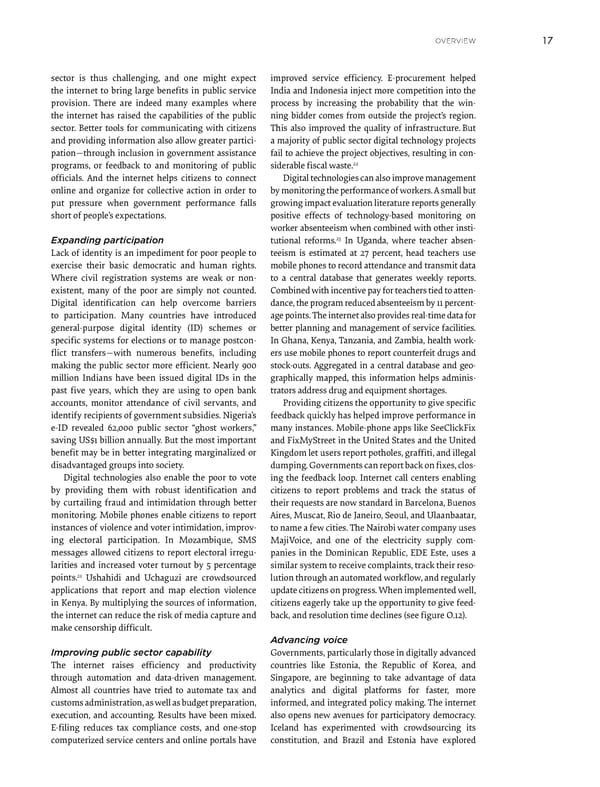overview 17 sector is thus challenging, and one might expect improved service efficiency. E-procurement helped the internet to bring large benefits in public service India and Indonesia inject more competition into the provision. There are indeed many examples where process by increasing the probability that the win- the internet has raised the capabilities of the public ning bidder comes from outside the project’s region. sector. Better tools for communicating with citizens This also improved the quality of infrastructure. But and providing information also allow greater partici- a majority of public sector digital technology projects pation—through inclusion in government assistance fail to achieve the project objectives, resulting in con- programs, or feedback to and monitoring of public siderable fiscal waste.22 officials. And the internet helps citizens to connect Digital technologies can also improve management online and organize for collective action in order to by monitoring the performance of workers. A small but put pressure when government performance falls growing impact evaluation literature reports generally short of people’s expectations. positive effects of technology-based monitoring on worker absenteeism when combined with other insti- Expanding participation 23 tutional reforms. In Uganda, where teacher absen- Lack of identity is an impediment for poor people to teeism is estimated at 27 percent, head teachers use exercise their basic democratic and human rights. mobile phones to record attendance and transmit data Where civil registration systems are weak or non- to a central database that generates weekly reports. existent, many of the poor are simply not counted. Combined with incentive pay for teachers tied to atten- Digital identification can help overcome barriers dance, the program reduced absenteeism by 11 percent- to participation. Many countries have introduced age points. The internet also provides real-time data for general- purpose digital identity (ID) schemes or better planning and management of service facilities. specific systems for elections or to manage postcon- In Ghana, Kenya, Tanzania, and Zambia, health work- flict transfers—with numerous benefits, including ers use mobile phones to report counterfeit drugs and making the public sector more efficient. Nearly 900 stock-outs. Aggregated in a central database and geo- million Indians have been issued digital IDs in the graphically mapped, this information helps adminis- past five years, which they are using to open bank trators address drug and equipment shortages. accounts, monitor attendance of civil servants, and Providing citizens the opportunity to give specific identify recipients of government subsidies. Nigeria’s feedback quickly has helped improve performance in e-ID revealed 62,000 public sector “ghost workers,” many instances. Mobile-phone apps like SeeClickFix saving US$1 billion annually. But the most important and FixMyStreet in the United States and the United benefit may be in better integrating marginalized or Kingdom let users report potholes, graffiti, and illegal disadvantaged groups into society. dumping. Governments can report back on fixes, clos- Digital technologies also enable the poor to vote ing the feedback loop. Internet call centers enabling by providing them with robust identification and citizens to report problems and track the status of by curtailing fraud and intimidation through better their requests are now standard in Barcelona, Buenos monitoring. Mobile phones enable citizens to report Aires, Muscat, Rio de Janeiro, Seoul, and Ulaanbaatar, instances of violence and voter intimidation, improv- to name a few cities. The Nairobi water company uses ing electoral participation. In Mozambique, SMS MajiVoice, and one of the electricity supply com- messages allowed citizens to report electoral irregu- panies in the Dominican Republic, EDE Este, uses a larities and increased voter turnout by 5 percentage similar system to receive complaints, track their reso- points.21 lution through an automated workflow, and regularly Ushahidi and Uchaguzi are crowdsourced applications that report and map election violence update citizens on progress. When implemented well, in Kenya. By multiplying the sources of information, citizens eagerly take up the opportunity to give feed- the internet can reduce the risk of media capture and back, and resolution time declines (see figure O.12). make censorship difficult. Advancing voice Improving public sector capability Governments, particularly those in digitally advanced The internet raises efficiency and productivity countries like Estonia, the Republic of Korea, and through automation and data-driven management. Singapore, are beginning to take advantage of data Almost all countries have tried to automate tax and analytics and digital platforms for faster, more customs administration, as well as budget preparation, informed, and integrated policy making. The internet execution, and accounting. Results have been mixed. also opens new avenues for participatory democracy. E-filing reduces tax compliance costs, and one-stop Iceland has experimented with crowdsourcing its computerized service centers and online portals have constitution, and Brazil and Estonia have explored
 World Development Report 2016 Page 29 Page 31
World Development Report 2016 Page 29 Page 31